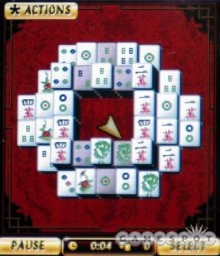Mahjong, the popular Chinese folk game, is a very appropriate game for the mobile medium--so it's kind of surprising that we haven't seen more games of this type. In any case, mobile mahjong now has a go-to game, because Jamdat Mahjong's attractive presentation and wealth of options put it at the top of the heap.

According to legend, mahjong was invented about 2,500 years ago in mainland China by Confucius, who wanted to inculcate the main tenets of his philosophy into a popular board game. As a result, a mahjong set contains many different types of tiles, which are engraved with Chinese ideograms, wildlife, and other symbols. The version of the game typically played in America (also called Shanghai) involves eliminating patterned stacks of tiles by creating like pairs. In order to remove tiles, they must be totally uncovered, have a free side, and match exactly--with the exception of tiles in the Flower or Season families. You win the game when you successfully remove the entire stack from the board.
At the outset, Jamdat Mahjong features five categories of stacks that have six different layouts each, for a total of 30 boards. If you complete all 30, an additional "Emperor" category will open up for bonus play. You can play Jamdat Mahjong in one of three ways: single-player, where you try to solve these boards as quickly as you can; multiplayer, in which two to four players can compete for the fastest time on a pass-and-play basis; or the timed Emperor's Challenge, during which you're working to beat the clock. The game automatically saves your progress in the single-player game, and it'll also offer you hints, for a small penalty to your time counter.
Jamdat Mahjong's tile-matching gameplay isn't exactly a strain, even on lower-end phones like the Motorola V551, but we were impressed by the game's overall feel. For instance, the menu graphics are high-quality pseudo-Asian affairs, with gold text against a red background. Meanwhile, the in-game cursor looks almost like a pointer from a PC game, and the tiles are easily identifiable. This game also makes efficient use of its sound. There's a pentatonic opening theme, and lots of shimmery sound effects during play. Unfortunately, there is a bit of a price to pay for all of this finery, since there's a small amount of loading time between screens. This doesn't impact the experience much.
Any mahjong or Shanghai fan is sure to be satisfied with Jamdat Mahjong, which even features comprehensive stat-tracking and an online leaderboard. It epitomizes great mobile board-game design: It's simple, it looks great, and it's loaded with useful features.